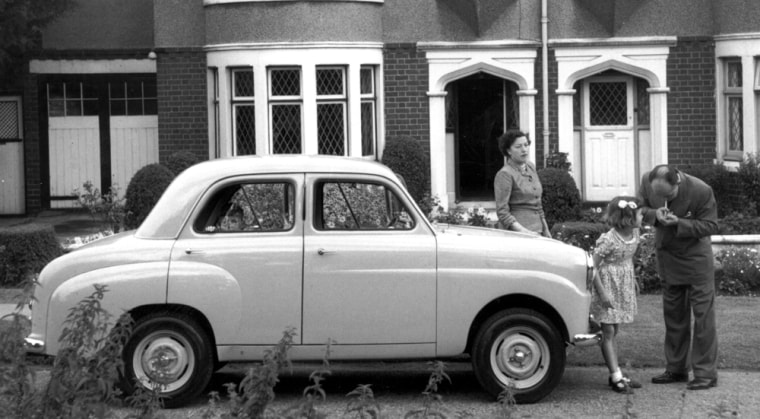I was down in Irvine, Calif., yesterday for a technical forum at Ford's California design center. The car was the new Ford Taurus, which has drawn some criticism for its latest redesign. Personally, I think it looks pretty cool, more like Ford’s current Lincoln sedan lineup than the company’s mass-market sedans of yore.
But what really got my attention was a comment that chief engineer Pete Reyes made during a brief spin we took in the car. He’s not supposed to speculate on the kind of volume that the new Taurus will do in terms of sales, but he did point out that the family sedan segment isn’t what it once was. And for that reason, Ford had to rethink the Taurus.
The New York Times’ Christopher Jensen recently took exception with the way that Ford has reworked this car over the past few years. However, it’s clear that if you want to sell people sedans these days, you need to recognize that the values that formerly dominated this market segment have changed. Why? Mainly because families aren’t that interested in sedans anymore.
American motoring has been defined by many, many cars, from snappy Corvettes in the late 1950s and early ’60s, to muscle cars in the late ’60s and early ’70s, to trucks and SUVs in the 1990s. But through it all, there’s been a collective belief in the auto industry that the family sedan is at the core of the business. When the Ford Taurus was first introduced, back in 1986, it was a radical departure from its boxy predecessors and produced a home run for the Blue Oval. (No wonder they brought back the name!) Both General Motors and Chrysler, as well as their Japanese competition, have always tried to do mid- and full-size mass-market sedans, on the assumption that these roomy freeway cruisers are what the majority of Americans want to drive.
But no longer. To put it bluntly, even big sedans aren’t big enough to haul around the bevy of sports gear, pets, and offspring that now make up many American families. In the 1990s, families began replacing their Buicks and Ford Tauruses with SUVs, and now they’ve moved on to a combination of SUVs and so-called “crossover” vehicles, which are essentially five- and seven-passenger SUVs built not on truck, but on car platforms, for better handling and fuel-efficiency. They’re the modern-day station wagons.
Slideshow 15 photos
Frankfurt Auto Show
The family sedan, meanwhile, has gone the way of the Dodo. But sedans are still in play. One of Ford’s most popular vehicles — one that sold like gangbusters during Cash for Clunkers — is the Focus. It’s a small sedan, however. So what does Ford do when it’s time to move that customer up to a larger car?
They have to lead with design, amenities, and luxury appointments. When I was a kid in the 1970s and ’80s, my father usually drove some kind of “family sedan” from GM: Pontiac Bonnevilles, assorted Chevys, Buicks, and so on. These were big, roomy cars, but they were far from luxurious. They weren’t exactly performance champs, either, but that wasn’t the point; the idea was to provide a certain amount of power and a nice, comfy ride. And a gigantic trunk.
Slip into a Ford Taurus today, however, and you can see my dad’s era rapidly receding. What you get instead is the latest iteration of the BMW experience. When BMW began bringing its “sport” sedans to the U.S. in the 1970s and ’80s, buyers immediately noticed that they were both more compact than American family sedans, and also more organized around the driving experience. (They were, after all, “the ultimate driving machine.”) You sat in a snug cockpit, bolstered into your seat, with instruments arrayed around you as if you’d been dropped into a fighter plane.
The early BMW approach has been softened and luxed-up, but the experience of sitting behind the wheel of a Beemer is still the same. And even if you’ve never owned or driven a BMW, if you’re in the market for a sedan, you’ve become a collective participant in the widespread desire to enjoy the BMW experience.
So the family sedan isn’t really put together for families anymore. It’s put together for people who aspire to own a German luxury/performance sedan, but might not want to pay the premium price for it. You can certainly put a family in a Ford Taurus — or a Toyota Avalon, or a Buick LaCrosse — but if you’re the gent driving, you’d want to be wearing Zegna rather than Patagonia, you’d want your spouse in high heels, your kids in premium denim, and your dog back at the house. And if you’re seeking a nice, mellow ride, you’re an anachronism. Today’s family sedans are designed to thrill the clan, not lull them to sleep.
Living in Los Angeles, I get to see BMW, Mercedes, and Lexus sedans on the road all the time. They never have families in them. And if current trends hold, they rarely will in the future.

